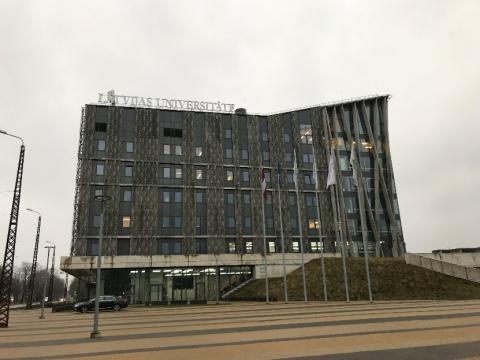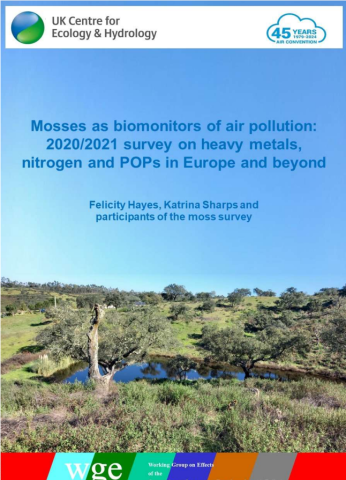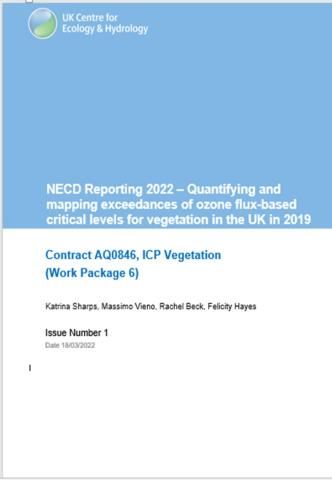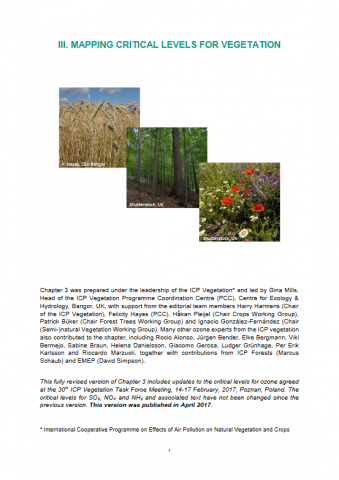
The 33rd ICP Vegetation Task Force Meeting was held from 27th – 30th January 2020 in Riga, Latvia. These annual meetings are a chance for ICP Vegetation participants to meet and present their latest research. Achievements over the past year, and also future plans are also discussed.
The meeting was organised this year by Dr Guntis Tabor and colleagues at the University of Latvia. On arrival in Riga on the Monday evening, we enjoyed a welcome reception at the very impressive university building, the House of Nature. This academic centre, built in 2015, houses the biology, chemistry and geography and earth sciences faculties of the university. It was the perfect setting for our meeting.
On the first full day of the meeting, there was a plenary session with a welcome address from the Deputy Director of the Latvian Department of Environmental Protection and the Dean of the Faculty of Biology at Latvia University. Harry Harmens (Chair of the ICP Vegetation) then gave an update on the achievements of the ICP Vegetation in 2019 and the future work plan, followed by an overview of the 2015 Moss Survey from Eiliv Steinnes and Marina Frontasyeva. After some further plenary talks of interest to both ozone and moss participants, there was a poster viewing session in the foyer of the building. The posters highlighted interesting new research for example, coastal wetland plant species as models in heavy metal and nitrogen accumulation studies and the response of the nutraceutical crop Amaranthus hypochondriacus to ozone stress.
After the poster session, there were two parallel sessions for the moss group and the ozone group for the rest of the day. Moss presentations included results on heavy metal concentrations in mosses in a wide variety of countries, data management and metrics and some preliminary results of the 2020-21 moss survey in the Moscow region.
Ozone presentations focused on ozone impacts on crops, the need to consider nitrogen and soil moisture when modelling ozone impacts and air pollution removal by urban trees. The group also discussed progress on the new chapters that will be added to Scientific Background Document B (https://icpvegetation.ceh.ac.uk/sites/default/files/ScientificBackgrounddocumentBNov17v2.pdf) This document contains supporting information for Chapter 3 of the Modelling and Mapping Manual, (https://icpvegetation.ceh.ac.uk/sites/default/files/FinalnewChapter3v4Oct2017_000.pdf) and includes information on developing areas of ozone research. New chapters include ‘Guidelines for assessing ozone-induced foliar damage on horticultural crops’; ‘Ozone impacts on insects’ and ‘Interactive impacts of ozone and nitrogen on crops.’
The weather in Riga was unseasonably mild (~ 1°C) so we were able to explore Riga city centre and enjoy some traditional Latvian food in the evening.
On the second day of the meeting, there were two presentation sessions for each group. The moss group covered a variety of interesting topics including moss bag biomonitoring, mapping element concentrations in moss specimens in Germany over time (1990-2015) and accumulation of microplastics in lichens. Ozone presentations included some novel aspects of ozone impacts, for example investigating if/how endophytic fungi may confer ozone tolerance to grass species and understanding the resistance of lichens and mosses to elevated ozone.
After lunch, we had the final plenary session, which included reporting back from the ozone and moss survey sessions, with decisions and actions; discussion of the medium-term work plan for ICP Vegetation from 2020 – 2022 and beyond; and decisions and recommendations from the 33rd ICP Vegetation Task Force Meeting. Minutes from the meeting are available from the Event page (https://icpvegetation.ceh.ac.uk/33rd-icp-vegetation-task-force-meeting).
We were then taken on an evening walking tour of Riga, passing famous sights including the House of the Black Heads, the Freedom Monument, the Three Brothers and Riga Cathedral. We had two very informative local guides who shared lots of interesting and fun facts about Riga, for example, we saw the Bremen Town Musicians Statue, depicting a donkey, a dog, a cat and a rooster. Touching the noses of each animal is thought to bring good luck! We also saw the two angry cat statues, perching on the roof of a Latvian home owner who was denied membership of the Great Guild. The cats were originally placed with their backs to the Guild as an insult.
After our walk, we were very pleased to enter the warmth of the University of Latvia buildings for the conference dinner. We all enjoyed the meal and a chance to chat with colleagues. We also said a farewell to Harry Harmens, the Chair of ICP Vegetation since 2004, who is retiring this year. Harry received a number of gifts including a memory book of photos from meetings over the years. We all thank Harry for his hard work over the last 16 years and we will miss him at next year’s meeting!
On the final day, a number of us went on the organised excursion to Bauska Castle and Rundale Palace in Southern Latvia. Bauska Castle consists of two separate buildings, with the older, ruined part dating to the 15th century while the more modern, intact portion (a fortified manor house) was built in the 16th century. We were given a tour of the manor house and enjoyed a talk on the clothing of the period and then some traditional dancing and games.
Rundale Palace is a baroque palace, built in the 1700s. The palace has a varied history, having been a residence for royalty, a school, a grain store and now a museum. Restoration works began in the 1970s and were completed in 2015. We enjoyed an informative tour of the interior of the palace. The palace also has extensive landscaped gardens, which would be lovely to visit in the summer.
The 33rd ICP Vegetation Task Force Meeting was a very successful and enjoyable meeting. We thank our hosts, Dr Guntis Tabor and colleagues at the University of Latvia, for all their hard work in organising the meeting and ensuring that it ran smoothly. Our annual meetings are a great way to catch up with new research in the field and to meet with colleagues to discuss ideas and future research. We look forward to next year’s meeting, which is provisionally scheduled to be held in Lithuania from 22nd – 25th February 2021. Further details will be added to the ICP Vegetation website in the autumn of 2020.


